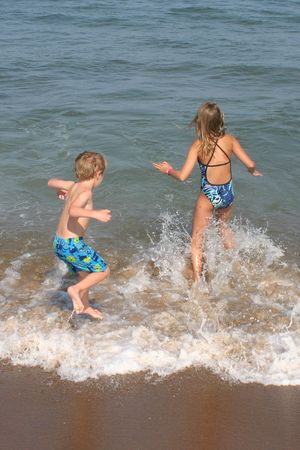When I was a child, something happened to friends of our family that changed how I thought about water safety forever.
The mother took her 3-year-old daughter to the beach near their house. She sat on the sand while her daughter played nearby -- and somehow, inexplicably and tragically, she fell asleep. When she woke up, her daughter had drowned.
Tragedies like these happen to other people, we often think. It doesn't happen to us.
Especially something like drowning, because that seems so simple to prevent: Go to places with lifeguards. Make sure your children can swim. Keep an ear out. Glance at the water regularly.
The problem is, none of that's enough.
I should say that I love the water. I grew up on the North shore of Long Island, and spent much of my childhood in or near water. I still spend a lot of time in or near water, as do my children --none of us can imagine anything different. But as much as I love water, I also respect and fear it.
It's a sunny day. You and your daughter had a bad night -- she kept waking up with an earache -- and you are both exhausted and cranky. After lunch, you decide to take her to the beach for a few minutes. It's spring, too cool for swimming, there won't be other kids to play with, but she loves it there. It will cheer you both up.
Two summers ago, in a public pool south of Boston with plenty of lifeguards, a woman slid to the bottom of the pool and drowned. There were people all around her, but the water was so murky that nobody saw her. That may seem like an extreme case, but actually, people drown with lifeguards present all the time. It's easy for lifeguards to be distracted by other swimmers, or by conversation, or by the myriad of things that can distract anyone.
You brought a chair to the beach, and you sit down in it with your daughter nearby. Together, you build a sand castle. She gets up and walks toward the water, looking for seashells. "Remember," you tell her, "don't go near the water." She comes back, sits and puts seashells on the castle. The sun is so warm on your face; you lean back in the chair, closing your eyes as you listen to the surf and to the sound of your daughter playing next to you. This was such a good idea, you think.
 Once I got caught in a rip current, or something like it. I suddenly found myself further out than I expected, and it was hard to swim back in. Luckily, I was not only a good swimmer, but I knew what to do: swim parallel to shore until I could swim back in. But not everyone is so lucky -- and good swimmers get tired, or hit their heads, or get tossed by waves and lose their bearings.
Once I got caught in a rip current, or something like it. I suddenly found myself further out than I expected, and it was hard to swim back in. Luckily, I was not only a good swimmer, but I knew what to do: swim parallel to shore until I could swim back in. But not everyone is so lucky -- and good swimmers get tired, or hit their heads, or get tossed by waves and lose their bearings.
What many people don't realize, too, is that drowning can be very silent. When a drowning person makes it to the surface, they don't scream or flail -- they take the biggest breath they can before they drop below the surface, and it may be less than a minute before they don't come up again (to learn more, check out the great post Drowning Doesn't Look Like Drowning by Mario Vittone).
According to the Centers for Disease Control and Prevention (CDC), most young children who drown in pools were last seen inside the house, had been out of sight for less than five minutes, and were in the care of one or both parents at the time.
You open your eyes. You feel odd. Could you possibly have fallen asleep? No -- you couldn't have done that. You wouldn't have done that. You look next to you -- your daughter isn't there. Panic rises in your throat as you jump to your feet and look frantically around you, screaming your daughter's name. You run to the water -- and see her, a few feet out, under the water, motionless.
This could happen to anyone. Including you.
•Learn life-saving skills. Everyone should learn to swim. Grownups (and older teens) should learn CPR.
•Fence it off. Pools should have fences that go completely around them, separating them from house or play areas, and have self-latching and self-locking gates.
•Use life jackets. The CDC suggests that children wear life jackets near any natural body of water, like a lake or ocean. They can help weaker swimmers in pools, too.
•Be on the lookout. When kids are in or near water (including the bathtub), an adult should be supervising them. Like staring at them. Not reading a book or sunbathing or otherwise multitasking. Staring at them.